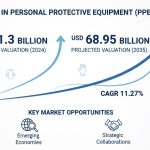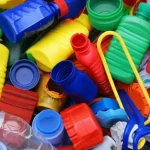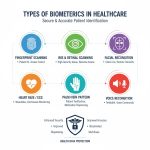The Recycled Plastic Revolution: How a $55 Billion Market is Reshaping Our Future
In an era where plastic bottles take 450 years to decompose and ocean gyres swirl with synthetic debris, the recycled plastic industry emerges as both an environmental necessity and an economic powerhouse. What was once dismissed as mere waste management has transformed into a sophisticated $55.46 billion global market in 2024, projected to surge to $132.55 billion by 2035. This remarkable growth trajectory, driven by an 8.25% compound annual growth rate, tells a story of innovation, regulation, and changing consumer consciousness that’s reshaping industries from packaging to automotive manufacturing.
Get a Sample Copy:- https://www.vantagemarketresearch.com/recycled-plastic-market-2365/request-sample
Key Takeaways:
- The global recycled plastic market is valued at $55.46 billion in 2024 and projected to reach $132.55 billion by 2035, growing at 8.25% CAGR.
- Polyethylene leads the market with 26% revenue share, followed by polypropylene, due to versatility in packaging and automotive applications.
- Packaging dominates applications with 37.4% market share, driven by e-commerce growth and corporate sustainability commitments.
- Asia Pacific controls 47.97% of the global market, with China and India showing fastest growth despite China’s plastic waste import ban.
- Plastic bottles represent 74.14% of recycled plastic sources, making them the primary feedstock for the industry.
- Major brands like Coca-Cola target 50% recycled content by 2030, while Nestlé aims for 100% recyclable packaging by 2025.
- Europe’s regulatory framework, including EU Plastics Strategy, mandates 30-65% recycled content in packaging by 2040.
- Downcycling remains a significant challenge, reducing material quality and limiting high-performance applications.
- China’s “National Sword” policy disrupted global waste flows but catalyzed domestic recycling infrastructure development.
- The market features moderate fragmentation with players like KW Plastics, Veolia, and Custom Polymers leading through scale and innovation.
- Construction and automotive sectors emerge as high-growth applications, leveraging recycled plastics for lightweighting and sustainability goals.
- Advanced technologies including AI-powered sorting and chemical recycling promise to overcome quality degradation challenges.
From Waste to Wonder: Understanding the Market Transformation
The recycled plastics market represents far more than simple waste diversion. It embodies a fundamental shift in how we perceive materials, moving from a linear “take-make-dispose” model to a circular economy where yesterday’s water bottle becomes tomorrow’s car bumper or construction material. This transformation didn’t happen overnight – it’s the result of converging forces including stricter environmental regulations, technological advances in recycling processes, and a growing awareness among consumers and corporations about sustainability imperatives.
The pandemic accelerated this shift in unexpected ways. As e-commerce exploded and takeout containers piled up, the demand for sustainable packaging solutions intensified. Companies scrambled to meet consumer expectations for environmental responsibility while maintaining product integrity and cost-effectiveness. Polyethylene terephthalate (PET), polyethylene, polypropylene, and polystyrene – the workhorses of the packaging industry – became prime candidates for recycling initiatives, creating a robust market for post-consumer materials.
The Polymer Portfolio: Breaking Down the Building Blocks
Polyethylene dominates the recycled plastic landscape, commanding 26% of market revenue in 2023. Its versatility explains this supremacy – from milk jugs to laundry detergent bottles, polyethylene pervades daily life. The material’s chemical stability and mechanical properties make it ideal for recycling, maintaining much of its original strength through multiple processing cycles.
Polypropylene follows closely, prized for its chemical resistance and fatigue-resistant properties. In automotive applications, recycled polypropylene finds new life in bumpers, interior trim, and under-hood components. The construction industry values it for piping systems and hinges that must withstand repeated stress without failure. This technical superiority, combined with cost advantages over virgin materials, drives adoption across sectors.
The sophistication of modern recycling extends beyond simple mechanical processing. Advanced sorting technologies using artificial intelligence and spectroscopic analysis can identify and separate different polymer types with unprecedented accuracy, ensuring higher quality outputs that meet stringent industry specifications.
Applications Across Industries: Where Recycled Plastics Find New Purpose
Packaging remains the largest application segment, accounting for 37.4% of market revenue in 2023. This dominance reflects both the volume of plastic packaging produced globally and the relative ease of collection through established recycling programs. Major brands have set ambitious targets – Nestlé aims for 100% recyclable or reusable packaging by 2025 while reducing virgin plastic use by 33%. The Coca-Cola Company’s “World Without Waste” initiative targets 50% recycled content in packaging by 2030.
The construction industry represents another significant growth area. Recycled plastics transform into composite lumber, roofing tiles, insulation materials, and even structural components. These applications leverage plastic’s durability, moisture resistance, and insulating properties while offering environmental benefits over traditional materials. In emerging economies like Brazil, China, and India, rapid infrastructure development combined with environmental consciousness creates perfect conditions for recycled plastic adoption in construction.
Automotive manufacturers increasingly turn to recycled plastics to meet lightweighting goals essential for fuel efficiency and emissions reduction. Every kilogram saved translates to reduced fuel consumption over a vehicle’s lifetime. Recycled materials now appear in everything from dashboard components to engine covers, with manufacturers like Honda and others leading the charge toward sustainable material sourcing.
Geographic Dynamics: A Global Perspective with Regional Nuances
Asia Pacific dominates the global recycled plastics market with nearly 48% of revenue share, driven by manufacturing prowess and growing environmental awareness. China’s market presents a paradox – while implementing strict bans on plastic waste imports through its “National Sword” policy, domestic recycling infrastructure expands rapidly. India’s “Swachh Bharat Mission” exemplifies government-led initiatives spurring market growth.
North America’s market, accounting for 18.27% of global revenue, benefits from mature collection infrastructure and strong regulatory frameworks. The United States leads in technological innovation, with companies developing advanced chemical recycling processes that can handle previously unrecyclable materials. State-level legislation, particularly in California and northeastern states, creates additional market drivers through mandatory recycled content requirements.
Europe’s circular economy ambitions position it as a regulatory leader. The EU Plastics Strategy mandates increasing recycled content levels – from 30% in 2025-2030 to 50-65% by 2040 for most packaging types. Countries like Germany, with its sophisticated deposit return schemes achieving 90% collection rates for beverage containers, demonstrate the potential of well-designed policy interventions.
Market Dynamics: Drivers, Challenges, and Opportunities
The recycled plastics market thrives on multiple growth drivers. Environmental consciousness among consumers creates demand pull, while regulatory push from governments worldwide ensures steady market expansion. Technological advances make recycling more efficient and economically viable, while corporate sustainability commitments provide stable demand for recycled materials.
However, challenges persist. Downcycling – the degradation of plastic properties through repeated recycling – limits applications for recycled materials in high-performance uses. Mixed plastic streams and contamination further complicate processing, often resulting in lower-quality outputs unsuitable for demanding applications like food-contact packaging or medical devices.
China’s import ban created significant disruption, forcing exporters to rapidly develop domestic processing capacity. This shock to the system exposed weaknesses in global recycling infrastructure but also catalyzed investment in local facilities and advanced sorting technologies. Southeast Asian countries, initially overwhelmed by redirected waste flows, responded with their own import restrictions, further emphasizing the need for localized solutions.
Opportunities abound for companies willing to invest in innovation. Chemical recycling technologies promise to break down plastics to their molecular components, enabling true circular recycling without quality degradation. Digital technologies including blockchain for supply chain transparency and AI for contamination detection open new possibilities for quality assurance and market confidence.
The Competitive Landscape: Players and Strategies
The recycled plastics market features a mix of established waste management companies, specialty recyclers, and major brands investing in vertical integration. Companies like KW Plastics, Veolia, and Custom Polymers lead through scale and technical expertise. Strategic partnerships, such as the African Plastics Recycling Alliance formed by Coca-Cola, Diageo, Nestlé, and Unilever, demonstrate collaborative approaches to market development.
Innovation drives competitive advantage. Companies investing in advanced sorting technologies, chemical recycling processes, and contamination reduction achieve higher quality outputs commanding premium prices. Others focus on specific polymer types or applications, developing deep expertise in niche markets.
Top Companies Covered in Market
- Veolia (France)
- Plastipak Holdings Inc. (U.S.)
- Biffa PLC (UK)
- Alpek (Mexico)
- MBA Polymers (U.S.)
- Cabka (Netherlands)
- Jayplas (UK)
- Loop Industries Inc. (Canada)
- Republic Services Inc. (U.S.)
- KW Plastics (U.S.)
- Stericycle (U.S.)
- Far Eastern New Century Corporation (Taiwan)
- Indorama Ventures (Thailand)
- Remondis SE & Co. KG (Germany)
- WM Intellectual Property Holdings LLC (U.S.)
- Waste Connections (U.S.)
- Clean Harbors Inc. (U.S.)
- Covetsro AG (Germany)
The Future of Recycled Plastics
The recycled plastics market stands at an inflection point. Convergence of environmental necessity, regulatory mandate, technological capability, and economic viability creates unprecedented growth opportunities. Success requires navigating complex challenges – from technical limitations of current recycling processes to geopolitical shifts in waste flows.
Companies and regions investing today in advanced recycling infrastructure, innovative technologies, and circular economy principles position themselves to capture value in this rapidly expanding market. The transformation from waste to resource represents more than an environmental imperative – it’s an economic opportunity measured in tens of billions of dollars and a chance to fundamentally reshape our relationship with materials.
As the market evolves from $55 billion to a projected $132 billion over the next decade, recycled plastics will transition from alternative to mainstream, from compromise to preferred choice. This shift promises environmental benefits, economic opportunities, and a more sustainable future where waste becomes obsolete and circularity becomes standard. The recycled plastic revolution has begun – the question isn’t whether to participate, but how quickly industries and nations can adapt to capture the opportunities it presents.
Market Segmentation
By Product
- Polyethylene (PE)
- Polyethylene Terephthalate (PET)
- Polypropylene (PP)
- Polyvinyl Chloride (PVC)
- Polystyrene (PS)
- Other Products
By Source
- Bottles (72%)
- Films
- Foams
- Fibers
- Other Sources
By End-Use Industry
- Packaging (36%)
- Building & Construction
- Electrical & Electronics
- Textiles
- Automotive
- Other End-Use Industries
FAQs –
- What is the projected market size of the global recycled plastic market by 2035?
- Which polymer type dominates the recycled plastic market and what is its market share?
- What are the main applications driving demand for recycled plastics?
- How did China’s “National Sword” policy impact the global recycled plastic market?
- Which region holds the largest market share in the recycled plastic industry and why?
- What is downcycling and how does it challenge the recycled plastic market growth?
- What are the key regulatory initiatives in Europe promoting recycled plastic adoption?
- Which companies are leading the global recycled plastic market?
- How has the COVID-19 pandemic influenced the demand for recycled plastics?
- What percentage of recycled content are major brands like Coca-Cola and Nestlé targeting in their packaging by 2030?
![[Market Research Reports] – Research Google News Blog | VMR.Biz](https://www.vmr.biz/wp-content/uploads/2022/12/logo-removebg-preview.png)











